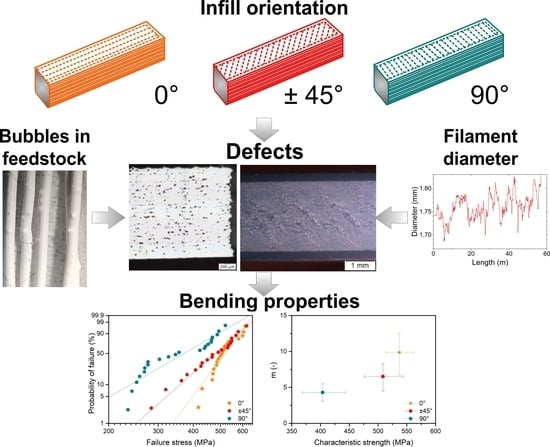Influence of the Infill Orientation on the Properties of Zirconia Parts Produced by Fused Filament Fabrication
Abstract
1. Introduction
2. Materials and Methods
2.1. Materials
2.2. Feedstock and Filament Production
2.3. Feedstock Evaluation
2.4. Sample Production
2.5. Characterization of Specimens
3. Results
3.1. Properties of the Feedstock
3.2. Properties of the FFF specimens
4. Discussion
5. Conclusions
Supplementary Materials
Author Contributions
Funding
Conflicts of Interest
References
- SmarTech Analysis; Ceramics Additive Manufacturing Production Markets: Crozet, VA, USA, 2020; pp. 2019–2030.
- Chen, Z.; Li, Z.; Li, J.; Liu, C.; Lao, C.; Fu, Y.; Liu, C.; Li, Y.; Wang, P.; He, Y. 3D printing of ceramics: A review. J. Eur. Ceram. Soc. 2019, 39, 661–687. [Google Scholar] [CrossRef]
- Travitzky, N.; Bonet, A.; Dermeik, B.; Fey, T.; Filbert-Demut, I.; Schlier, L.; Schlordt, T.; Greil, P. Additive Manufacturing of Ceramic-Based Materials. Adv. Eng. Mater. 2014, 16, 729–754. [Google Scholar] [CrossRef]
- Zocca, A.; Colombo, P.; Gomes, C.M.; Günster, J.; Green, D.J. Additive Manufacturing of Ceramics: Issues, Potentialities, and Opportunities. J. Am. Ceram. Soc. 2015, 98, 1983–2001. [Google Scholar] [CrossRef]
- Moritz, T.; Maleksaeedi, S. Additive manufacturing of ceramic components. In Additive Manufacturing: Materials, Processes, Quantifications and Applications; Zhang, J., Jung, Y.-G., Eds.; Elsevier: Cambridge, MA, USA, 2018; pp. 105–161. [Google Scholar]
- Wang, J.-C.; Dommati, H.; Hsieh, S.-J. Review of additive manufacturing methods for high-performance ceramic materials. Int. J. Adv. Manuf. Technol. 2019, 103, 2627–2647. [Google Scholar] [CrossRef]
- Du, W.; Ren, X.; Pei, Z.; Ma, C. Ceramic Binder Jetting Additive Manufacturing: A Literature Review on Density. J. Manuf. Sci. Eng. 2020, 142, 1–66. [Google Scholar] [CrossRef]
- Agarwala, M.K.; Jamalabad, V.R.; Langrana, N.A.; Safari, A.; Whalen, P.J.; Danforth, S.C. Structural quality of parts processed by fused deposition. Rapid Prototyp.J. 1996, 2, 4–19. [Google Scholar] [CrossRef]
- McNulty, T.F.; Mohammadi, F.; Bandyopadhyay, A.; Shanefield, D.J.; Danforth, S.C.; Safari, A. Development of a binder formulation for fused deposition of ceramics. Rapid Prototyp. J. 1998, 4, 144–150. [Google Scholar] [CrossRef]
- Fang, T.; Jafari, M.A.; Danforth, S.C.; Safari, A. Signature analysis and defect detection in layered manufacturing of ceramic sensors and actuators. Mach. Vis. Appl. 2003, 15, 63–75. [Google Scholar] [CrossRef]
- Gorjan, L.; Reiff, L.; Liersch, A.; Clemens, F. Ethylene vinyl acetate as a binder for additive manufacturing of tricalcium phosphate bio-ceramics. Ceram. Int. 2018, 44, 15817–15823. [Google Scholar] [CrossRef]
- Cano, S.; Gonzalez-Gutierrez, J.; Sapkota, J.; Spoerk, M.; Arbeiter, F.; Schuschnigg, S.; Holzer, C.; Kukla, C. Additive manufacturing of zirconia parts by fused filament fabrication and solvent debinding: Selection of binder formulation. Addit. Manuf. 2019, 26, 117–128. [Google Scholar] [CrossRef]
- Nötzel, D.; Hanemann, T. Filament development for the additive manufacturing of ceramic parts via Fused Deposition Modelling (FDM). In Proceedings of the 92nd DKG Annual Meeting and Symposium on High Performance Ceramics, Berlin, Germany, 19–22 March 2017. [Google Scholar]
- Damon, J.; Dietrich, S.; Gorantla, S.; Popp, U.; Okolo, B.; Schulze, V. Process porosity and mechanical performance of fused filament fabricated 316L stainless steel. Rapid Prototyp. J. 2019, 27, 1319–1327. [Google Scholar] [CrossRef]
- Thompson, Y.; Gonzalez-Gutierrez, J.; Kukla, C.; Felfer, P. Fused filament fabrication, debinding and sintering as a low cost additive manufacturing method of 316L stainless steel. Addit. Manuf. 2019, 30, 100861. [Google Scholar] [CrossRef]
- Fan, N.C.; Chen, Y.Y.; Wei, W.C.J.; Liu, B.H.; Wang, A.B.; Luo, R.C. Porous Al2O3 catalyst carrier by 3D additive manufacturing for syngas reforming. J. Ceram. Process. Res. 2017, 18, 676–682. [Google Scholar]
- Iyer, S.; McIntosh, J.J.; Bandyopadhyay, A.; Langrana, N.A.; Safari, A.; Danforth, S.C.; Clancy, R.B.; Gasdaska, C.J.; Whalen, P.J. Microstructural Characterization and Mechanical Properties of Si3N4 Formed by Fused Deposition of Ceramics. Int. J. Appl. Ceram. Technol. 2008, 5, 127–137. [Google Scholar] [CrossRef]
- Gorjan, L.; Tonello, R.; Sebastian, T.; Colombo, P.; Clemens, F. Fused deposition modeling of mullite structures from a preceramic polymer and γ-alumina. J. Eur. Ceram. Soc. 2019, 39, 2463–2471. [Google Scholar] [CrossRef]
- Conzelmann, N.A.; Gorjan, L.; Sarraf, F.; Poulikakos, L.D.; Partl, M.N.; Müller, C.R.; Clemens, F.J. Manufacturing complex Al2 O3 ceramic structures using consumer-grade fused deposition modelling printers. Rapid Prototyp. J. 2020, 26, 1035–1048. [Google Scholar] [CrossRef]
- de Calan, Guillaume (2020): Benchmark of AM technologies. Nanoe Webinar. Nanoe. Ballainvilliers, France, 12 May 2020. Available online: https://nanoe.com/en/nanoe/ (accessed on 18 May 2020).
- Orlovská, M.; Chlup, Z.; Bača, Ľ.; Janek, M.; Kitzmantel, M. Fracture and mechanical properties of lightweight alumina ceramics prepared by fused filament fabrication. J. Eur. Ceram. Soc. 2020. [Google Scholar] [CrossRef]
- Moritz, T.; Müller-Köhn, A.; Abel, J.; Scheithauer, U.; Weingarten, S. Ceramic Injection Moulding and Ceramic Additive Manufacturing side by side: Opportunities and challenges. Powder Inject. Mould. Int. 2018, 12, 77–84. [Google Scholar]
- Abel, J.; Scheithauer, U.; Janics, T.; Hampel, S.; Cano, S.; Müller-Köhn, A.; Günther, A.; Kukla, C.; Moritz, T. Fused Filament Fabrication (FFF) of Metal-Ceramic Components. JoVE 2019. [Google Scholar] [CrossRef]
- Kukla, C.; Cano, S.; Moritz, T.; Müller-Köhn, A.; Courtney, P.; Hampel, S.; Holzer, C. Multimaterial Components by Material Extrusion-Fused Filament Fabrication (ME-FFF) - Production of an Infrared Heater. Ceram. Forum Int. 2019, 96, 22–27. [Google Scholar]
- Jafari, M.A.; Han, W.; Mohammadi, F.; Safari, A.; Danforth, S.C.; Langrana, N.A. A novel system for fused deposition of advanced multiple ceramics. Rapid Prototyp. J. 2000, 6, 161–175. [Google Scholar] [CrossRef]
- Fuenmayor, E.; Forde, M.; Healy, A.V.; Devine, D.M.; Lyons, J.G.; McConville, C.; Major, I. Material Considerations for Fused-Filament Fabrication of Solid Dosage Forms. Pharmaceutics 2018, 10, 44. [Google Scholar] [CrossRef]
- Turner, B.N.; Gold, S.A. A review of melt extrusion additive manufacturing processes: II. Materials, dimensional accuracy, and surface roughness. Rapid Prototyp.J. 2015, 21, 250–261. [Google Scholar] [CrossRef]
- Munsch, M.; Schmidt-Lehr, M.; Wycisk, E. Metal Additive Manufacturing with Sinter-Based Technologies; AM Power Insights No. 4, 2018. Available online: https://am-power.de/en/insights/additive-manufacturing-sinter-based-technologies/ (accessed on 23 April 2020).
- Gibson, I.; Rosen, D.; Stucker, B. Additive Manufacturing Technologies. 3D Printing, Rapid Prototyping, and Direct Digital Manufacturing; Springer: New York, NY, USA, 2015; ISBN 978-1-4939-2113-3. [Google Scholar]
- Nötzel, D.; Eickhoff, R.; Hanemann, T. Fused Filament Fabrication of Small Ceramic Components. Materials 2018, 11, 1463. [Google Scholar] [CrossRef] [PubMed]
- Lengauer, W.; Duretek, I.; Fürst, M.; Schwarz, V.; Gonzalez-Gutierrez, J.; Schuschnigg, S.; Kukla, C.; Kitzmantel, M.; Neubauer, E.; Lieberwirth, C.; et al. Fabrication and properties of extrusion-based 3D-printed hardmetal and cermet components. J. Refract. Hard. Met. 2019, 82, 141–149. [Google Scholar] [CrossRef]
- Zhang, Y.; Bai, S.; Riede, M.; Garratt, E.; Roch, A. A comprehensive study on Fused Filament Fabrication of Ti-6Al-4V structures. Addit. Manuf. 2020, 34, 101256. [Google Scholar] [CrossRef]
- Waalkes, L.; Längerich, J.; Holbe, F.; Emmelmann, C. Feasibility study on piston-based feedstock fabrication with Ti-6Al-4V metal injection molding feedstock. Addit. Manuf. 2020, 35, 101207. [Google Scholar] [CrossRef]
- Rane, K.; Petrò, S.; Strano, M. Evolution of porosity and geometrical quality through the ceramic extrusion additive manufacturing process stages. Addit. Manuf. 2020, 32, 101038. [Google Scholar] [CrossRef]
- Yu, T.; Zhang, Z.; Liu, Q.; Kuliiev, R.; Orlovskaya, N.; Wu, D. Extrusion-based additive manufacturing of yttria-partially-stabilized zirconia ceramics. Ceram. Int. 2020, 46, 5020–5027. [Google Scholar] [CrossRef]
- Kurose, T.; Abe, Y.; Santos, M.V.A.; Kanaya, Y.; Ishigami, A.; Tanaka, S.; Ito, H. Influence of the Layer Directions on the Properties of 316L Stainless Steel Parts Fabricated through Fused Deposition of Metals. Materials 2020, 13, 2493. [Google Scholar] [CrossRef]
- Ahn, S.-H.; Montero, M.; Odell, D.; Roundy, S.; Wright, P.K. Anisotropic material properties of fused deposition modeling ABS. Rapid Prototyp. J. 2002, 8, 248–257. [Google Scholar] [CrossRef]
- Feilden, E.; Blanca, E.G.-T.; Giuliani, F.; Saiz, E.; Vandeperre, L. Robocasting of structural ceramic parts with hydrogel inks. J. Eur. Ceram. Soc. 2016, 36, 2525–2533. [Google Scholar] [CrossRef]
- Goh, G.D.; Yap, Y.L.; Tan, H.K.J.; Sing, S.L.; Goh, G.L.; Yeong, W.Y. Process–Structure–Properties in Polymer Additive Manufacturing via Material Extrusion: A Review. Crit. Rev. Solid State Mater. Sci. 2020, 45, 113–133. [Google Scholar] [CrossRef]
- Koch, C.; van Hulle, L.; Rudolph, N. Investigation of mechanical anisotropy of the fused filament fabrication process via customized tool path generation. Addit. Manuf. 2017, 16, 138–145. [Google Scholar] [CrossRef]
- Tosoh Corporation. Advanced Ceramics: Zirconia Powders. Available online: https://www.tosoh.com/our-products/advanced-materials/zirconia-powders (accessed on 4 July 2020).
- Bagley, E.B. End Corrections in the Capillary Flow of Polyethylene. J. Appl. Phys. 1957, 28, 624–627. [Google Scholar] [CrossRef]
- Eisenschitz, R.; Rabinowitsch, B.; Weissenberg, K. Zur Analyse des Formveraenderungswiderstandes. Mitt. Dtsch. Mater. 1929, 9, 91–94. [Google Scholar]
- Rabinowitsch, B. Über die Viskosität und Elastizität von Solen. Z. Phys. Chem. 1929, 145A, 1–26. [Google Scholar] [CrossRef]
- DIN EN 843-1:2008-08. Hochleistungskeramik—Mechanische Eigenschaften monolithischer Keramik bei Raumtemperatur—Teil_1: Bestimmung der Biegefestigkeit; Deutsche Fassung EN_843-1:2006; Beuth Verlag GmbH: Berlin, Germany, 2008. [Google Scholar]
- DIN EN 843-5. Hochleistungskeramik—Mechanische Eigenschaften Monolithischer Keramik bei Raumtemperatur—Teil 5: Statistische Auswertung; Deutsche Fassung EN 843-5:2006; Beuth Verlag GmbH: Berlin, Germany, 2006. [Google Scholar]
- Danzer, R.; Lube, T.; Supancic, P.; Damani, R. Fracture of Ceramics. Adv. Eng. Mater. 2008, 10, 275–298. [Google Scholar] [CrossRef]
- Rangarajan, S.; Qi, G.; Venkataraman, N.; Safari, A.; Danforth, S.C. Powder Processing, Rheology, and Mechanical Properties of Feedstock for Fused Deposition of Si3N4 Ceramics. J. Am. Ceram. Soc. 2000, 83, 1663–1669. [Google Scholar] [CrossRef]
- Venkataraman, N.; Rangarajan, S.; Matthewson, M.J.; Safari, A.; Danforth, S.C.; Yardimci, A.; Guceri, S.I. Mechanical and Rheological Properties of Feedstock Material for Fused Deposition of Ceramics and Metals (FDC and FDMet) and their Relationship to Process Performance. In Proceedings of the Solid Freeform Fabrication Symposium. Laboratory for Freeform Fabrication, University of Texas, Austin, TX, USA, 9–11 August 1999. [Google Scholar]
- Xie, H.; Jiang, J.; Yang, X.; He, Q.; Zhou, Z.; Xu, X.; Zhang, L. Theory and practice of rapid and safe thermal debinding in ceramic injection molding. Int. J. Appl. Ceram. Technol. 2019, 44, 2718. [Google Scholar] [CrossRef]
- Mutsuddy, B.C.; Ford, R.G. Ceramic Injection Moulding; Chapman & Hall: London, UK, 1995; ISBN 0412538105. [Google Scholar]
- Eichler, J.; Rödel, J.; Eisele, U.; Hoffman, M. Effect of Grain Size on Mechanical Properties of Submicrometer 3Y-TZP: Fracture Strength and Hydrothermal Degradation. J. Am. Ceram. Soc. 2007, 90, 2830–2836. [Google Scholar] [CrossRef]
- Shao, H.; Zhao, D.; Lin, T.; He, J.; Wu, J. 3D gel-printing of zirconia ceramic parts. Ceram. Int. 2017, 43, 13938–13942. [Google Scholar] [CrossRef]
- Lu, Y.; Mei, Z.; Zhang, J.; Gao, S.; Yang, X.; Dong, B.; Yue, L.; Yu, H. Flexural strength and Weibull analysis of Y-TZP fabricated by stereolithographic additive manufacturing and subtractive manufacturing. J. Eur. Ceram. Soc. 2020, 40, 826–834. [Google Scholar] [CrossRef]
- Munz, D.; Fett, T. Ceramics: Mechanical Properties, Failure Behaviour, Materials Selection; Springer International Publishing: Cham, Switzerland, 1999; ISBN 978-3-642-58407-7. [Google Scholar]
- Lawn, B. Fracture of Brittle Solids; Cambridge University Press: Cambridge, UK, 1993; ISBN 9780511623127. [Google Scholar]
- Rueda, M.M.; Auscher, M.-C.; Fulchiron, R.; Périé, T.; Martin, G.; Sonntag, P.; Cassagnau, P. Rheology and applications of highly filled polymers: A review of current understanding. Prog. Polym. Sci. 2017, 66, 22–53. [Google Scholar] [CrossRef]
- Hausnerova, B. Rheological characterization of powder injection molding compounds. Polimery 2010, 55, 3–11. [Google Scholar] [CrossRef]
- Kukla, C.; Duretek, I.; Gonzalez-Gutierrez, J.; Holzer, C. Rheology of Highly Filled Polymers. In Rheology of Highly Filled Polymers; Rivera-Armenta, J.L., Cruz, B.A.S., Kukla, C., Duretek, I., Gonzalez-Gutierrez, J., Holzer, C., Eds.; InTechOpen Limited: London, UK, 2018; ISBN 978-1-78984-001-8. [Google Scholar]
- Hausnerová, B.; Sáha, P.; Kubát, J.; Kitano, T.; Becker, J. Rheological Behaviour of Hard-Metal Carbide Powder Suspensions at High Shear Rates. Polym. Eng. Sci. 2000, 20, 4. [Google Scholar] [CrossRef]
- Hausnerová, B.; Sáha, P.; Kubát, J. Capillary Flow of Hard-Metal Carbide Powder Compounds. IPP 1999, 14, 254–260. [Google Scholar] [CrossRef]
- Birinci, E.; Kalyon, D.M. Development of extrudate distortions in poly(dimethyl siloxane) and its suspensions with rigid particles. J. Rheol. 2006, 50, 313–326. [Google Scholar] [CrossRef]
- Cano, S.; Gooneie, A.; Kukla, C.; Rieß, G.; Holzer, C.; Gonzalez-Gutierrez, J. Modification of Interfacial Interactions in Ceramic-Polymer Nanocomposites by Grafting: Morphology and Properties for Powder Injection Molding and Additive Manufacturing. Appl. Sci. 2020, 10, 1471. [Google Scholar] [CrossRef]
- Semakina, O.K.; Phomenko, A.N.; Leonteva, A.A.; Rymanova, I.E. Research of Surface Properties of Fillers for Polymers. Procedia Chem. 2015, 15, 79–83. [Google Scholar] [CrossRef]
- Chao, F.; Bowler, N.; Tan, X.; Liang, G.; Kessler, M.R. Influence of adsorbed moisture on the properties of cyanate ester/BaTiO3 composites. Compos. Part A ApplSci. Manuf. 2009, 40, 1266–1271. [Google Scholar] [CrossRef]
- Gilmer, E.L.; Miller, D.; Chatham, C.A.; Zawaski, C.; Fallon, J.J.; Pekkanen, A.; Long, T.E.; Williams, C.B.; Bortner, M.J. Model analysis of feedstock behavior in fused filament fabrication: Enabling rapid materials screening. Polymer 2018, 152, 51–61. [Google Scholar] [CrossRef]
- Godec, D.; Cano, S.; Holzer, C.; Gonzalez-Gutierrez, J. Optimization of the 3D Printing Parameters for Tensile Properties of Specimens Produced by Fused Filament Fabrication of 17-4PH Stainless Steel. Materials (Basel) 2020, 13, 774. [Google Scholar] [CrossRef] [PubMed]
- Costa, A.E.; Ferreira da Silva, A.; Sousa Carneiro, O. A study on extruded filament bonding in fused filament fabrication. Rapid Prototyp. J. 2019, 25, 555–565. [Google Scholar] [CrossRef]
- Kosmač, T.; Oblak, C.; Jevnikar, P.; Funduk, N.; Marion, L. The effect of surface grinding and sandblasting on flexural strength and reliability of Y-TZP zirconia ceramic. Dent Mater. 1999, 15, 426–433. [Google Scholar] [CrossRef]
- Harrer, W.; Schwentenwein, M.; Lube, T.; Danzer, R. Fractography of zirconia-specimens made using additive manufacturing (LCM) technology. J. Eur. Ceram. Soc. 2017, 37, 4331–4338. [Google Scholar] [CrossRef]
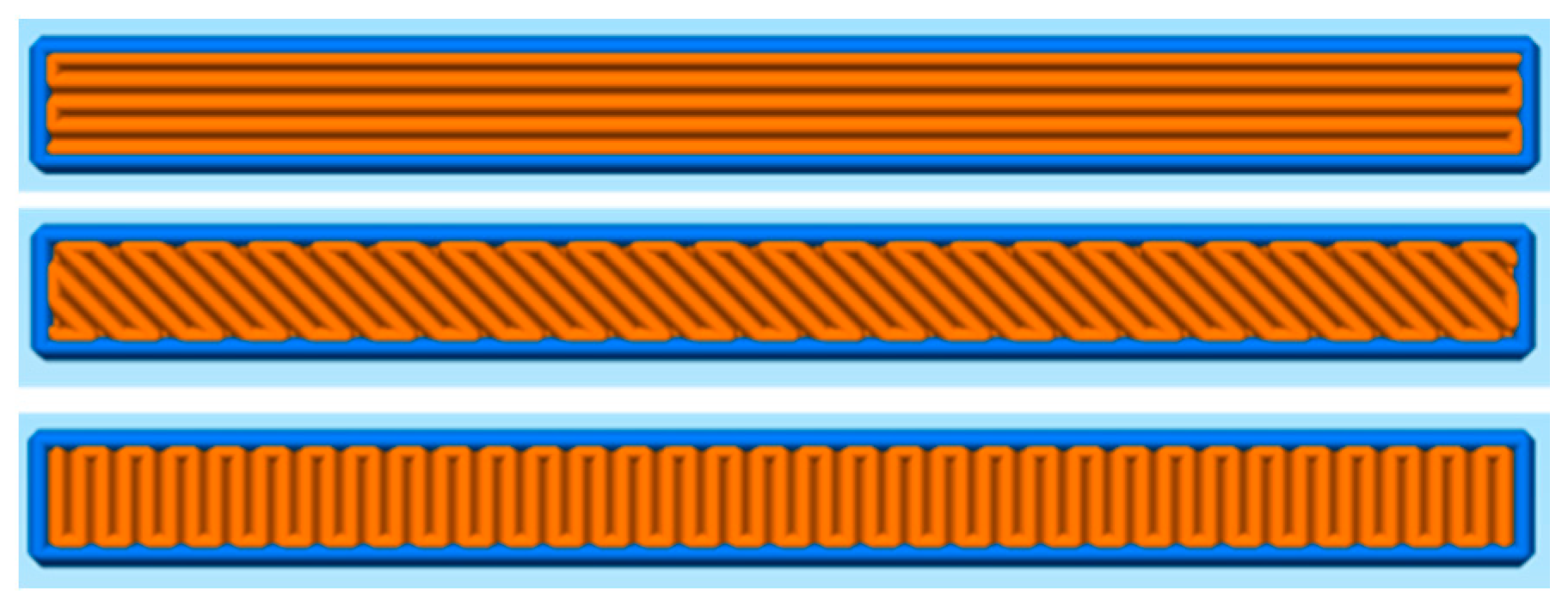
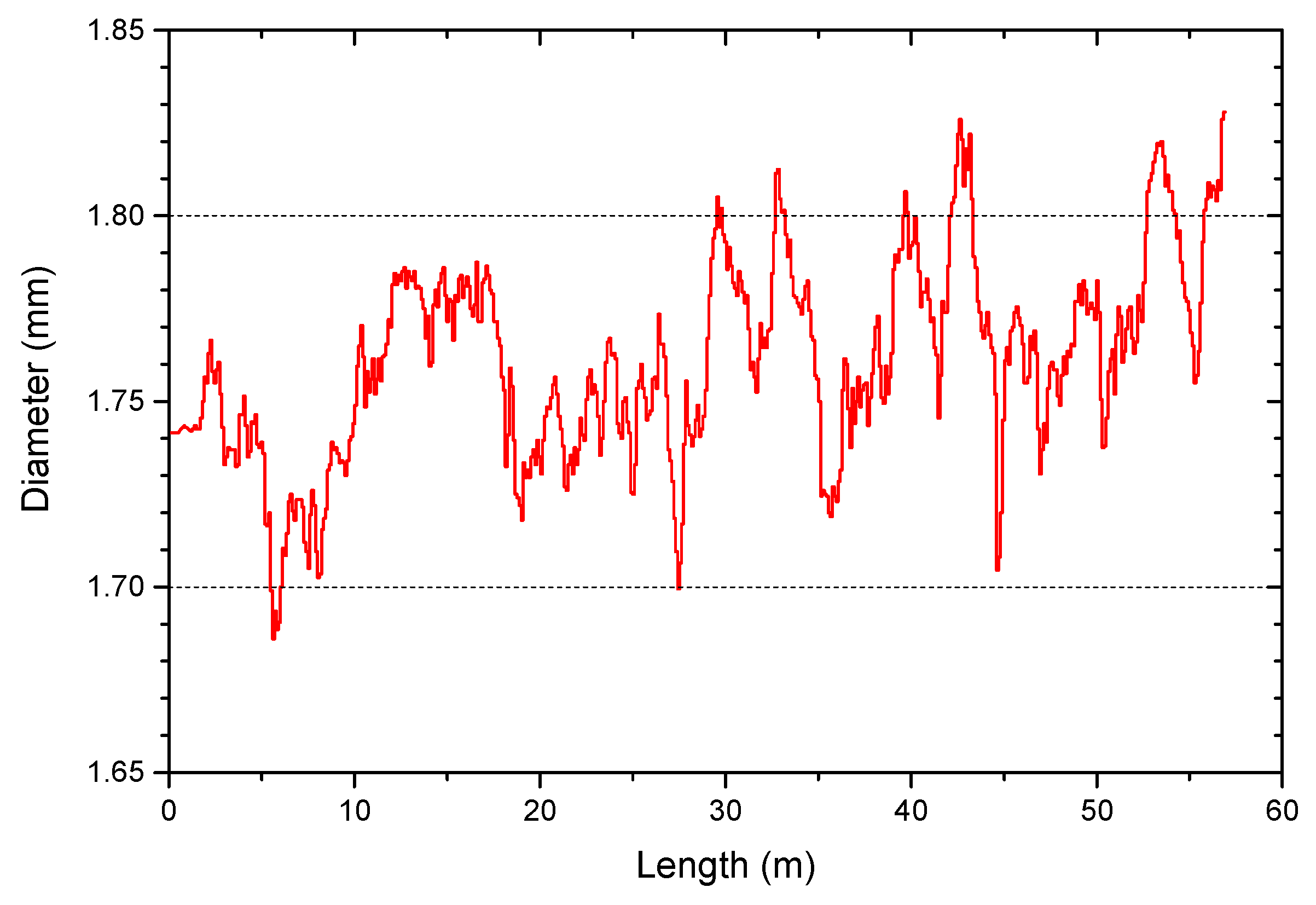


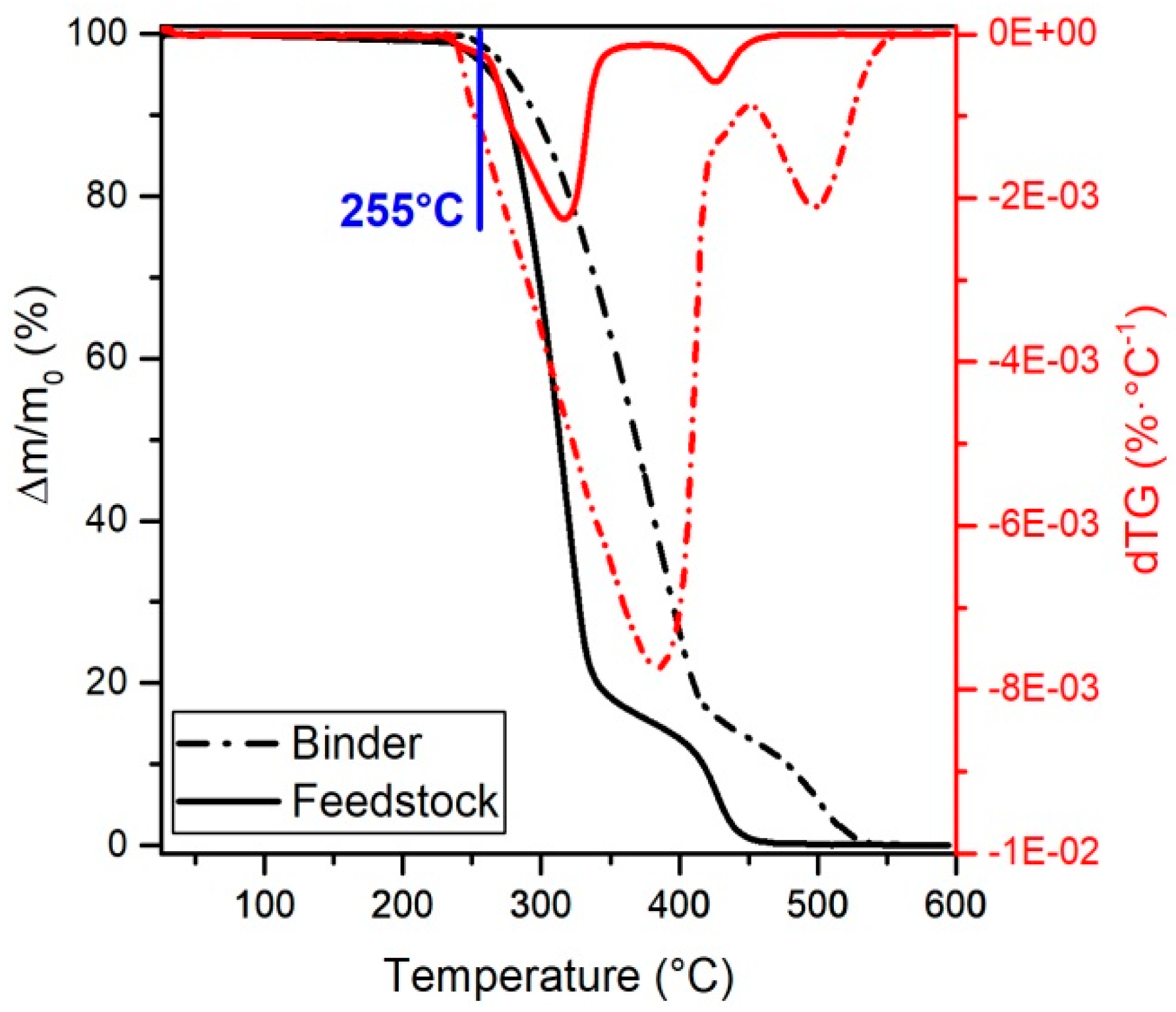
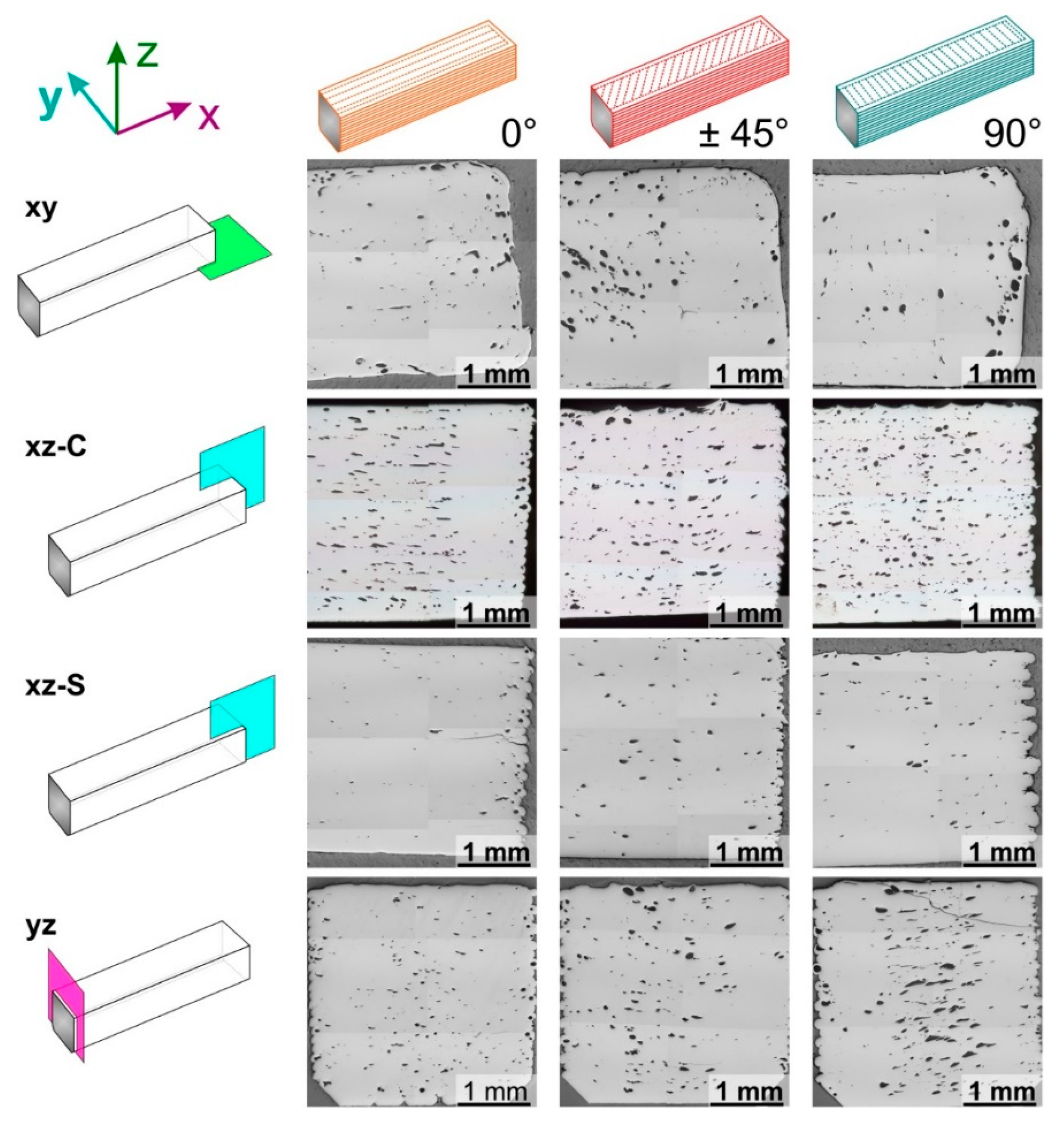
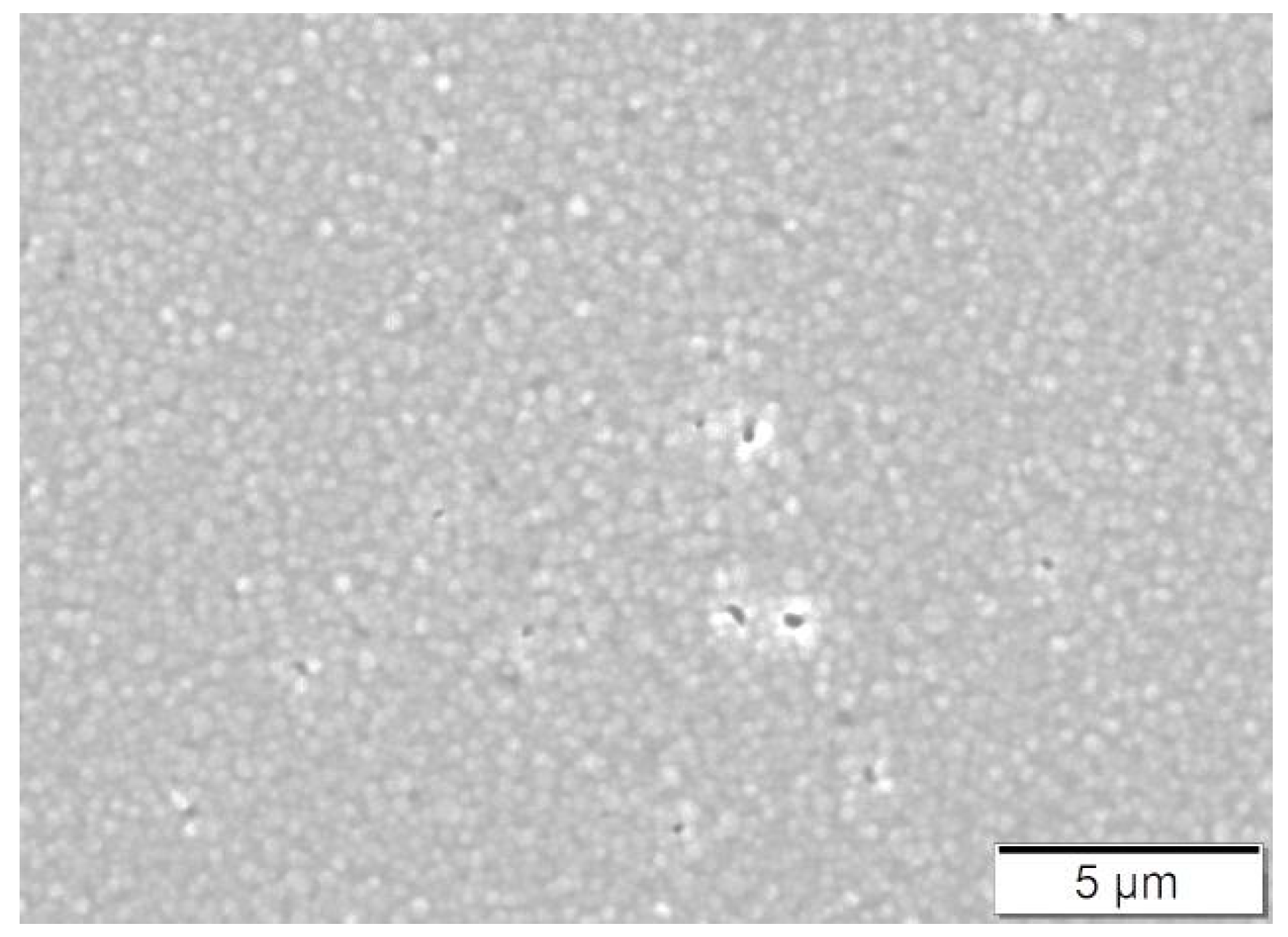

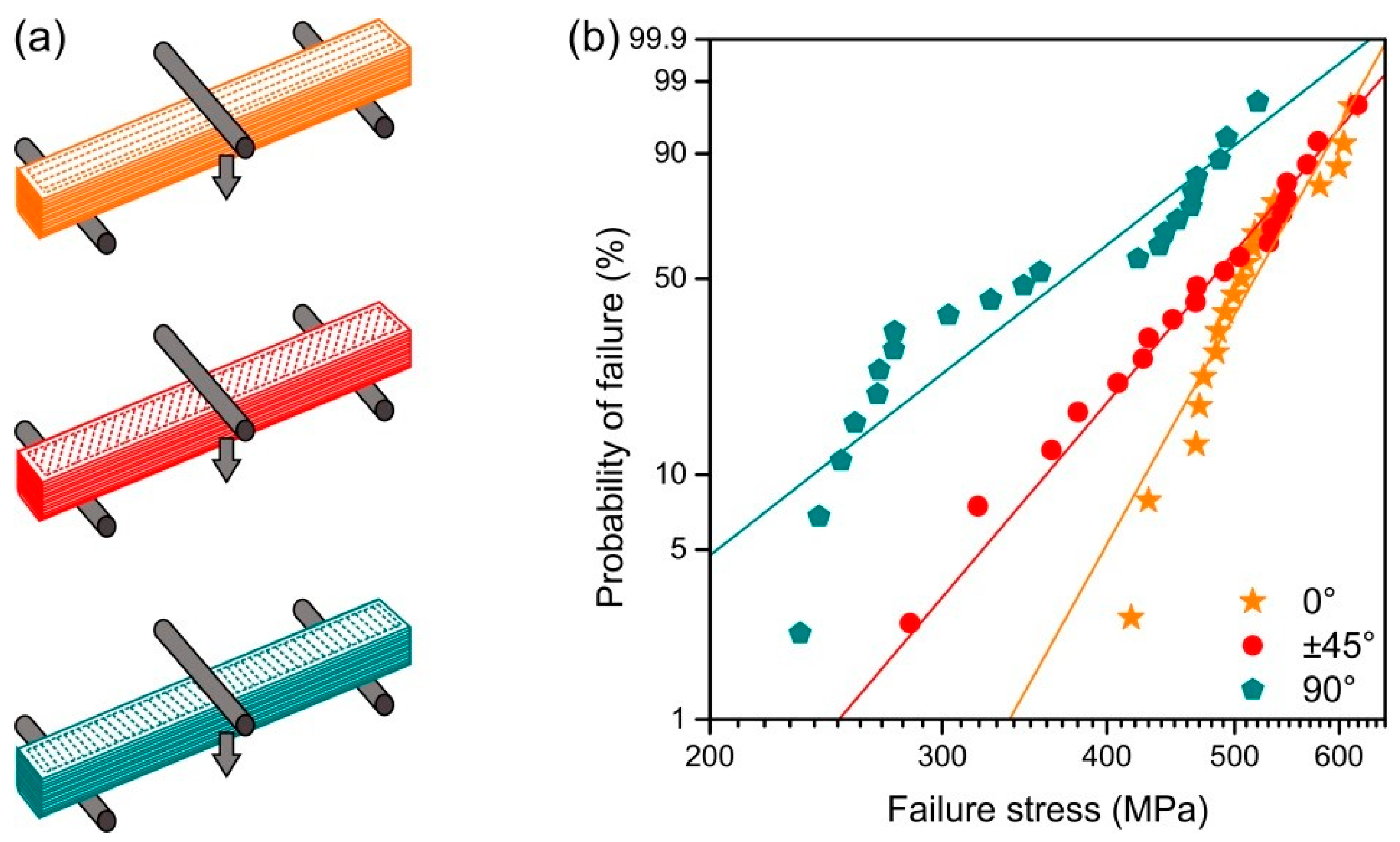
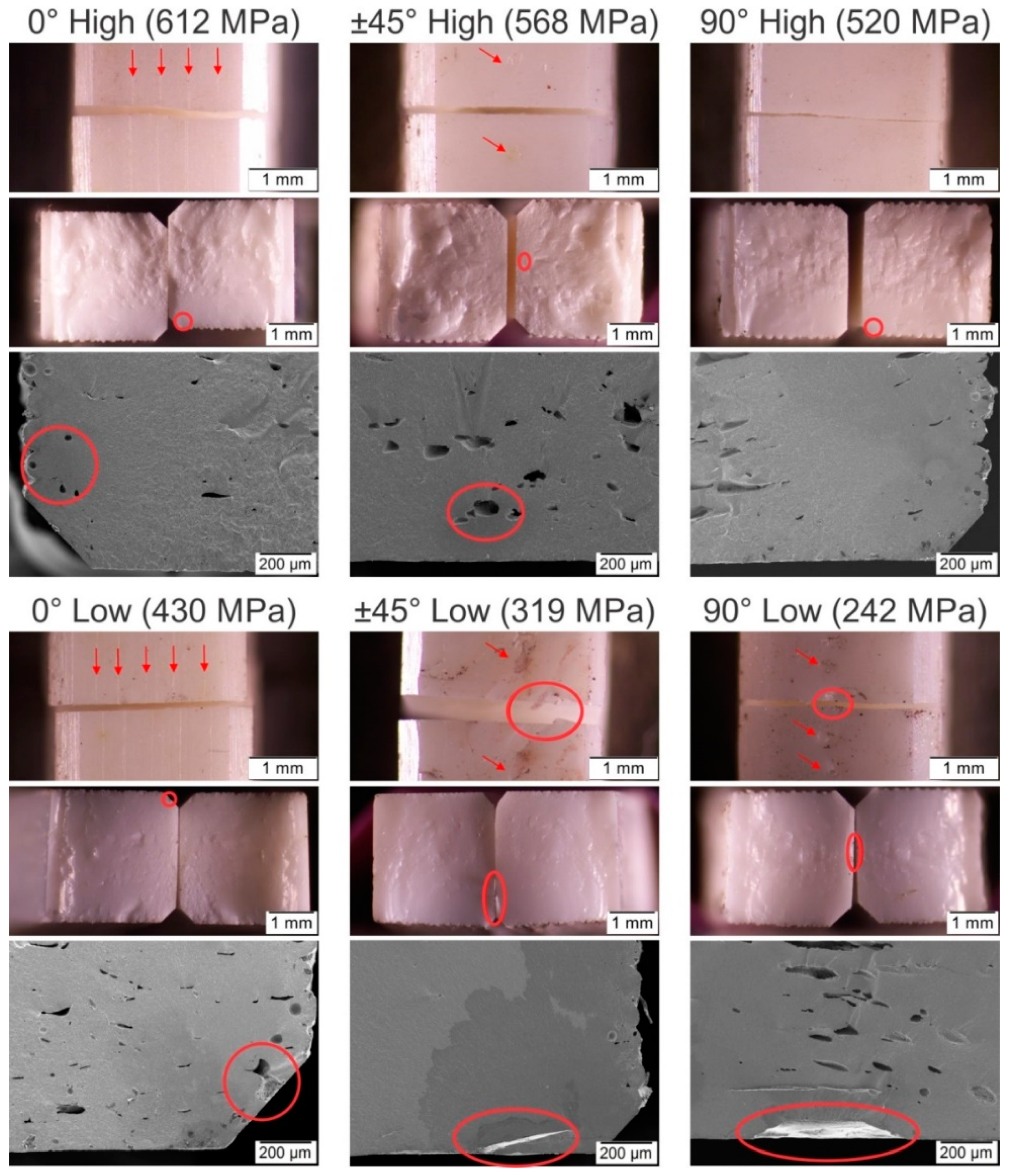

| Theoretical | Actual | Control Build Cycle | |||||||
|---|---|---|---|---|---|---|---|---|---|
| Infill Orientation | mg (g) | mg (g) | mg (g) | ms (g) | Δm (wt %) | 1 ρg (g/cm3) | 1 ρs (g/cm3) | ρrg (%) | ρrs (%) |
| 0° | 1.702 | 1.706 ± 0.029 | 1.723 ± 0.01 | 1.464 ± 0.01 | 15.06 ± 0.07 | 3.254 ± 0.003 | 5.943 ± 0.013 | 98.73 ± 0.08 | 98.23 ± 0.22 |
| ±45° | 1.703 | 1.72 ± 0.041 | 1.77 ± 0.007 | 1.487 ± 0.042 | 15.08 ± 0.03 | 3.202 ± 0.024 | 5.878 ± 0.034 | 97.15 ± 0.71 | 96.97 ± 0.64 |
| 90° | 1.694 | 1.72 ± 0.034 | 1.642 ± 0.004 | 1.396± 0.003 | 15 ± 0.06 | 3.176 ± 0.007 | 5.797 ± 0.015 | 96.35 ± 0.21 | 95.82 ± 0.26 |
| Technology | Infill Orientation | m (-) [90% CI] | σ0 (MPa) [90% CI] | σ (MPa) |
|---|---|---|---|---|
| 0° | 9.9 [6.7–12.6] | 537 [514–562] | 512 ± 55 | |
| FFF (MEX) | ±45° | 6.5 [4.5–8.3] | 508 [477–543] | 473 ± 90 |
| 90° | 4.3 [3.1–5.5] | 404 [368–443] | 366 ± 99 | |
| 3D Gel Printing (MEX) [53] | 0° | 28 1 | 462 1 | 450 ± 20 |
| Digital Light Processsing (VPP) and polishing [54] | - | 9.3 [6.7–12.3] | 1066 [1031–1101] | 1013 ± 126 |
| Subtractive method [54] | - | 12 [8.7–15.8] | 1206 [1173–1239] | 1158 ± 114 |
© 2020 by the authors. Licensee MDPI, Basel, Switzerland. This article is an open access article distributed under the terms and conditions of the Creative Commons Attribution (CC BY) license (http://creativecommons.org/licenses/by/4.0/).
Share and Cite
Cano, S.; Lube, T.; Huber, P.; Gallego, A.; Naranjo, J.A.; Berges, C.; Schuschnigg, S.; Herranz, G.; Kukla, C.; Holzer, C.; et al. Influence of the Infill Orientation on the Properties of Zirconia Parts Produced by Fused Filament Fabrication. Materials 2020, 13, 3158. https://doi.org/10.3390/ma13143158
Cano S, Lube T, Huber P, Gallego A, Naranjo JA, Berges C, Schuschnigg S, Herranz G, Kukla C, Holzer C, et al. Influence of the Infill Orientation on the Properties of Zirconia Parts Produced by Fused Filament Fabrication. Materials. 2020; 13(14):3158. https://doi.org/10.3390/ma13143158
Chicago/Turabian StyleCano, Santiago, Tanja Lube, Philipp Huber, Alberto Gallego, Juan Alfonso Naranjo, Cristina Berges, Stephan Schuschnigg, Gemma Herranz, Christian Kukla, Clemens Holzer, and et al. 2020. "Influence of the Infill Orientation on the Properties of Zirconia Parts Produced by Fused Filament Fabrication" Materials 13, no. 14: 3158. https://doi.org/10.3390/ma13143158
APA StyleCano, S., Lube, T., Huber, P., Gallego, A., Naranjo, J. A., Berges, C., Schuschnigg, S., Herranz, G., Kukla, C., Holzer, C., & Gonzalez-Gutierrez, J. (2020). Influence of the Infill Orientation on the Properties of Zirconia Parts Produced by Fused Filament Fabrication. Materials, 13(14), 3158. https://doi.org/10.3390/ma13143158







